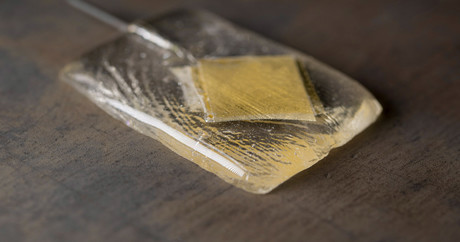Heat-resistant transducers developed

Researchers at the Fraunhofer Institute for Silicate Research ISC have successfully realised piezo sensors for high-temperature applications. Unlike conventional sensors, the transducers can continuously monitor components that are as hot as 900°C.
If a component such as a steam pipe in a coal-fired power station has a crack, corrosion or other flaw, repairing it is imperative. Ultrasonic sensors mounted externally can detect flaws like these, but only when the component does not heat up to more than around 200°C. Above that temperature, conventional piezoelectric materials can no longer determine pressure, force, voltage or acceleration or act as a gas sensor. Furthermore, at these temperatures any plastic encapsulations that are not heat resistant will fail.
The challenge for the Fraunhofer researchers lay in constructing standard piezoelectric crystals that can withstand long-term use as sound transducers on hot components. Especially problematic is the adhesive that coats the sensors and attaches them to the component: it can’t withstand very high temperatures.
“That’s why we use glass solder as both a glue and a housing material,” said Dr Bernhard Brunner, head of the Application Technology department at Fraunhofer ISC’s Center Smart Materials. This means the glass belonging to this group of adhesives must withstand not only heat, but also the several hundred degrees difference between the ambient temperature in the room and the operating temperature of the component.
While the steel in the component expands significantly when it is heated, the dimensions of the crystal change only marginally. The glass solder in which the sensor is embedded has to endure these deformations without shattering. To this end, the researchers coat the sensor with multiple layers consisting of different glass solders that are perfectly compatible with each other as well as with the component’s material specifications. To ensure that the electric signalling lines do not corrode in high temperatures, the feed lines are made of precious metals such as platinum.
The resulting transducers work the same as other piezo sensors. First they are mounted externally on the component, eg, a hot steel pipe. When an alternating voltage is applied to the piezoelectric crystal, it mechanically deforms and sends an ultrasonic wave into the material. After the sound wave, the sensor switches to receive and detects the signal reflected by the component.
In most cases, the sensor receives the same original signal it sent. However, if the component is cracked or has a corroded spot, the defect alters the reflected signal and indicates the defect’s location. When several transducers are used that serve as transmitter and receiver, the location of the flaw can be pinpointed exactly to within a few millimetres. Depending on the component’s material, the sensor’s range covers a few metres.
The ultrasonic sensors have already been implemented at temperatures of up to 600°C. Additionally, the sensors remain stable over long periods — at least two years in any use case — and for many applications, researchers expect a service life of several decades.
Spinning, twisted light could power next-generation electronics
Researchers have created an organic semiconductor that forces electrons to move in a spiral...
Improving the way flash memory is made
Researchers are developing the ideal manufacturing process for a type of digital memory known as...
Optical memory unit boosts processing speed
Researchers have developed a fast, versatile volatile photonic memory that could enhance AI,...





